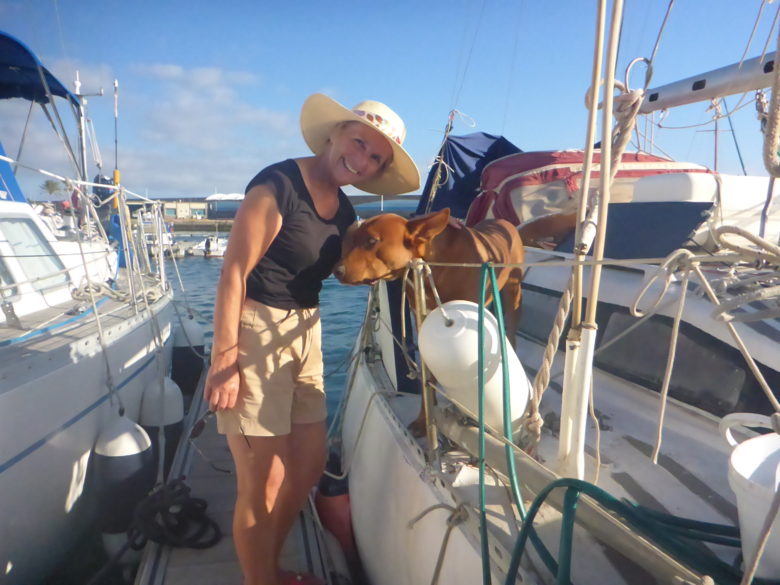30th October 2015
On approach to the harbour of Puerto del Rosario it looked as if there was not much there but industry, apartments and offices and indeed it is not a tourist town at all, but it is the island capital and the pilot book said “The beach protection mole remains well sheltered by the cruise ship quay and the holding is good in sand”.
The good old African Sirocco wind has for centuries blown golden sand to these shores building up protective dunes along the shores. I looked forward to giving the place a chance, just as I had in Seixal in Spain with its hidden secrets and charm.
The hook bit well and soon a fine steel junk-rigged ketch from Rotterdam was anchored near us. We went ashore in baking sun, with an empty Camping Gaz Butane cylinder in the trolley. Soon we surmised that as this charming place was not geared up for visiting yachts they would be unlikely to cater for foreign Gas bottles. But in the exploration we came across many smiles in a busy town full of big sculptures and statues telling its history and massive models of shells reflecting its association with the sea. Murals painted on the walls of buildings added colour and interest to otherwise featureless architecture. Children made their way home from school and suited men with briefcases did their daily business.
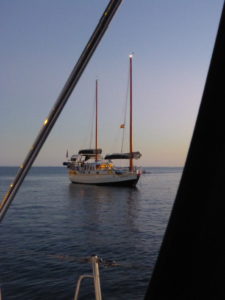
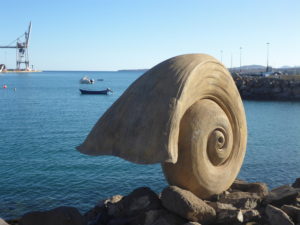

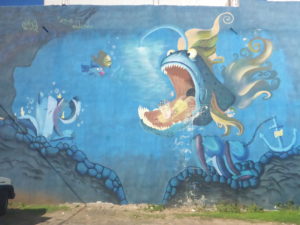
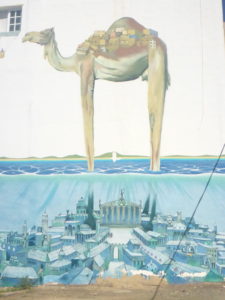
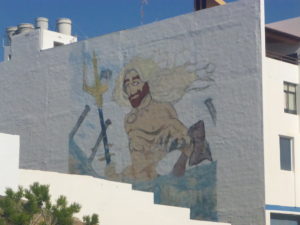
At the open Tourist Information Office on the promenade another member of this elite breed of enthusiasts told us in perfect English, with passion, all he could about his island. Teams of school children and university students are involved in an ongoing project to reinstate colonies of turtles on the beaches to the south. When the turtles are old enough to release GPS trackers are attached so their progress can be studied. A tick in the box for conservation. He also gave us some ideas on places to visit away from the capital. But he could not think of anywhere that would be showing the Rugby Final the next day!
Back in the harbour ships came and went a few feet away and planes took off towards us from the airport to the south, with amazing frequency. There must be a whole bunch of tourists somewhere! Around us the local sailing school tutored youngsters in Optimist dinghies and teenagers in the faster 420s dashed around. Woman were coaching crews of four in the rowing boats, sometimes really yelling at the kids, poor things I thought and wished I understood the language. Rob’s iphone and the Navtex revealed a weather front was due to pass through the next day.
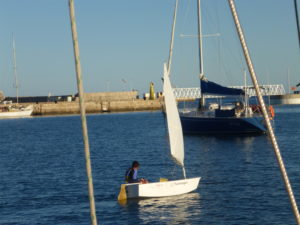
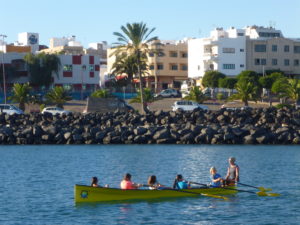
31st October, “Where’s the wind and rain Barbs?” Rob asked from his position while reading in bed. I looked at him from my favourite meerkat lookout in the aft hatch and pointed north. “It’s coming babe.” Minutes later the weather set in for the day. But we were not to be put off going ashore to the sailing school slipway a few metres distant. The outboard on the backof the dinghy would ensure we would not be blown away.
In the modern three floor shopping mall (aimed largely at cruise liner customers judging by the chic fashion shops full with warm winter clothes) we shopped in the Hypo Dino supermarket and found more Irish butter and fresh Canary cow milk. Yep those UK visitors must be here somewhere. Toyshops were full with Halloween accessories and we wondered if we would get a firework display that night.
Back aboard and unpacked we sat and watched the sailing enthusiasts deal with the fresh wind. The Oppies stayed closer in towards the slipway but the older ones took the advantage of some good practice in stronger airs. Parents waited in their cars for their youngsters to return.

Another sailing yacht arrived, with a Swedish couple. Then a German yacht came in dragging along fish net and line caught around his rudder. He anchored and made every attempt to clear it and retrieve it aboard. He managed to fill a bin liner but despite many attempts more of it seemed to be trapped around something on the sea-bed, so he marked it with a float and left the next morning. Mental note for when we leave, to avoid the area offshore from the visible float.
On the first day of November and one sole firework later we walked to the bus station, as usual on the outskirts of town, and took the number 6 to Corralejo at the north of the island. We had motored past it on the way. Once a small fishing village and now completely submerged by tourism, this is where many of the tourists are! In between Isla Lobos and the beach is a vast shallow area where the swell builds up to long, cresting rollers which are perfect for surfing on boards and in canoes.
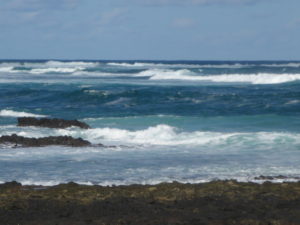
It reminded me of Widemouth Bay in Cornwall but with the added protection of the island. This otherwise exposed coast has led the developers to build well back from the shore. Instead there is a wide promenade where everyone can enjoy the exercise and views.
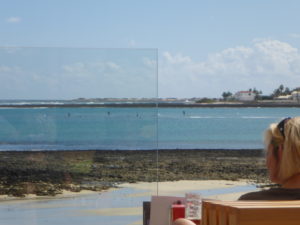
Eggyolk-streaked pavements were testament to the Halloween fun the night before. As is true of all significant human developments there was the Chinese Bazaar, and on the well proven theory we went in to buy a tiny battery for one of our anti-mosquito devices, and yes the lady had one almost in her hand ready, amazing. As we ate tasty tapas we watched a canoeist row his big black dog back to his boat and thought of Toby, and his love of being on board.
The return bus gave us a fine view of the beautiful dunes that stretch for miles along the coast but not before passing ugly half-built tourist ventures that missed the boom and could do with being flattened. But I guess even that costs money.
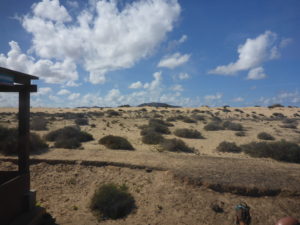
We love sitting in the cockpit people watching. A man with a Harris hawk is giving it flying practise from the cruise liner quay. I have just told a Red Cross rib, out for some exercises, to mind the white float in case it gets caught on their propeller. Rob is playing at fishing while at anchor, using some of the rods and gear he had as a boy. So all is well on the good ship Zoonie as we hope it is with you.
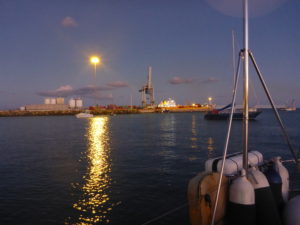
Later.
Last night two Germans said they were leaving as they did not like the look of the place (Rosario) and there was nothing here for them. Funny how there are as many perceptions of places as people visiting them.
Next morning we rowed ashore saying hello to the Frenchman who spends his time ‘minding’ his and other moored boats, and the local fisherman making his way home with his catch, “Hola, Buenos Dias.”
The small well filled little bus sped us westwards towards the volcanoes past goat farms and dry gulches where the swirls of mud illustrated the torrents of water that must surge down them in the rains. As we climbed cyclists were struggling up the steep inclines and I gasped as the bus sped around tight bends in the middle of the road revealing long rocky drops from the side of the road. At least there were no overturned buses down them as I had seen in the US.
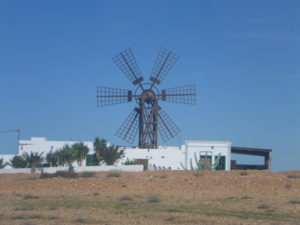
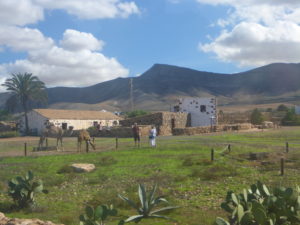
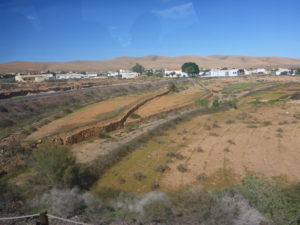
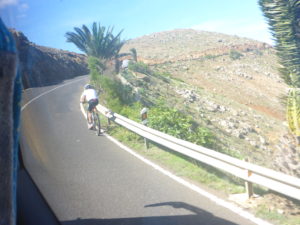
Betancuria is a significant little town lying hidden from the world, either side of a carefully walled ravine in a fertile and picturesque valley. Jean de Bethencourt, of Normandy, invaded back in the 14th century and for the locals it was a case of submit or die. Betancuria became the governing capital of the Canaries because it was well protected from the coast and risk of invasion. But as time marched on each island became self-governing to a degree and Gran Canaria took supremacy in many matters.
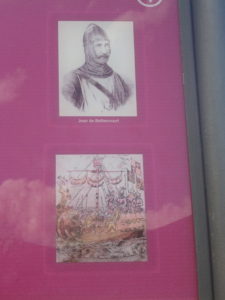
Now it is the historical capital and many families, including the owners of Casa Santa Maria and the 5th generation of the Gonzalez Dumpierrez family who owned the Princess Arminda restaurant where we had a light lunch, have returned to rebuild their previously derelict estates and they are now successful enterprises for locals and visitors alike.
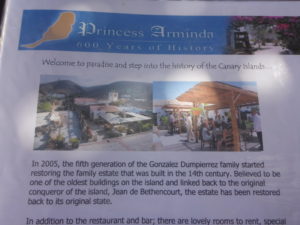
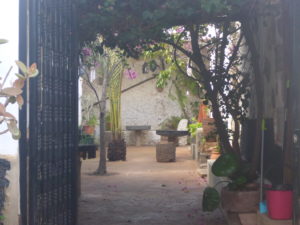
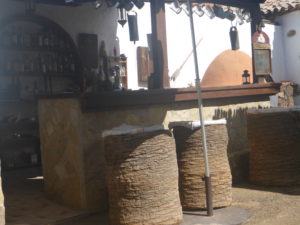
We watched a slide show about the island in springtime and for a brief time it becomes a colourful carpet of poppies and daisies and many other flowers covering what seemed to us to be square miles of barren plains. To trap the precious rain, fields are built of dry stone walls topped with soil. They are called gavias and with the valuable vegetable and goat farming industry they are still very much in use.

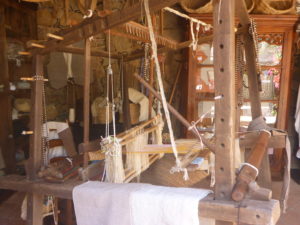
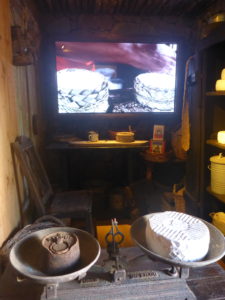
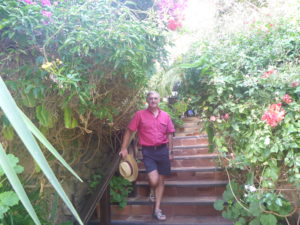
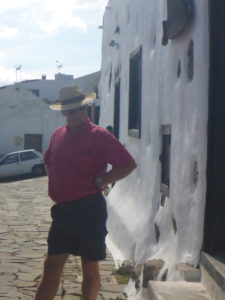
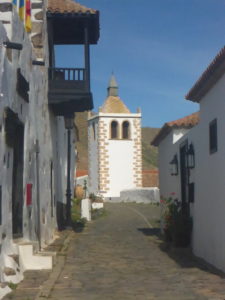
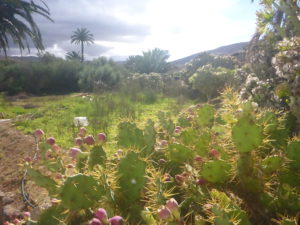
As we sat at the bus stop awaiting our transport we heard the clicking of the watering system that gave the individual trees and shrubs life in a beautiful garden by the road. Above us two peregrine falcons were buzzing a pair of buzzards. Ring necked doves pecked at crumbs outside the eateries and wood pigeons gave their gentle, summery call. We learned that song thrushes, yellow-eyed rock curlews, blue tits and finches also frequent the countryside, along with our old friend, the sparrow. A return visit in springtime would be worthwhile!
4th November. To Gran Tarajal Marina.
Farewell to the friendly Frenchman, and the local who exercises his Harris Hawk from the cruise-liner terminal when it is unoccupied and to the lovely raven haired lass at Freteria Tino Bar, our local, who after a few days of practise, would have our beers ready for us shortly after we arrived without our even saying a word!
Motoring because the wind was light, we passed shoreline caves with vertical basalt columns, reminding me of Fingal’s Cave, voluptuous lava flows now warmed by the sun, steep, rocky, sharp cliffs where no human foot has ever trod in millions of years and 1000’s of acres of remoteness accentuated by tiny hamlets and sole simple homesteads. The earthy rustic colours, reds, oranges and pinks change as the sun moves over them and against the intense blue sky the volcanoes are beautiful, in my view anyway.
Finally we rounded the last headland and the wind increased enough for the genoa to take us the last few miles. The anchorage did not feel too appealing as the afternoon breeze was funnelling around the headland so we took up residence in the protection of the harbour.
A few minutes later, after another successful visit to tourist information, I was sitting in the recommended Dory Monroy peluqueros hair salon awaiting my fate. I kept looking in the mirror at Rob to see if he approved or should I yell “stop” but he was engrossed in a magazine. Rob’s Peniche hair experience was on the other foot now(!) And you can’t really ask the lady to stop halfway through anyway can you! Ok, the long and the very short is I have had to trim Rob’s hair this morning just to say mine is still longer. It’s cool, pixie-ish and should not need another trim for at least six months!
The other visiting yachts are from Austria, Germany, Norway, France and a couple of English. Four young lads, three Spanish and one English left the harbour in an inflatable under outboard last evening to do some speargun fishing. We were relieved to hear their motor returning since it was now after dark. They had caught numerous fish by torchlight, including squid, mullet, and a reddy brown big fish worth 80 Euros in the market.
Another very pleasurable task this morning, as the temperature is over 30’, is to wash the fridge ensuring that I lean right in, feet off the floor and reach the deepest corners!
WOMAD Fuerteventura is setting up for an international music festival this weekend with fabulous colourful banners. (Wonder if they would miss one!) Roadies in Stetson’s are busy with the vast amount of preparation to be done. Stall holders are setting up shop and the fair is getting ready too. We will stay for a visit this evening and leave tomorrow for Morro Jable if they have room for a night or two before sailing overnight to somewhere on the south coast of Gran Canaria, preferably somewhere with some washing machines!
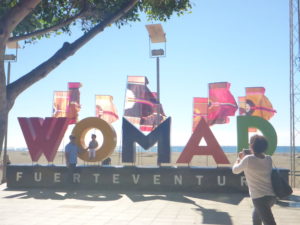
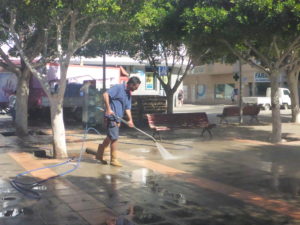
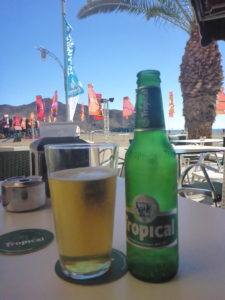
7th November. Dune grass, a deserted marina and dilapidated yacht.
Just in case our fishing exploits ended in failure we bought a (very expensive) Dentex Sea Bass which we deemed would last for two meals and set off for Morro Jable on a broad reach in a roly sea with 6 – 12 knots of juice.
For thousands of years the African Sirocco wind has obligingly blown golden, naturally sieved sand across to the east coast of these islands, providing fine beaches and good anchoring. All along the coast the mini volcanic peaks were transformed into enormous sand covered dunes bonneted with stabilising dune grass. In amongst them elaborate hotel complexes, some built to look like mosques and castles with turrets and domes, lay like eggs in soft foliaged tree nests.
Morro Jable Marina.
As it was Saturday there appeared to be no staff around so it was up to us to find a space on the only two pontoons that were used by visitors. We tied up in between two yachts one of which told us a lot about its owner. Probably he was a liveaboard who had holed up here many years ago and decided to stay.
All around the handrails odd lengths of string (including bale string) and rope were stored some of them well on the path of decomposition. The sails had long since gone and the parcel tape that secured the protective covers on the self-steering rudder and wind vane flew in fine ribbons on the wind. The decks were covered with what would normally be stowed below as if the little vessel had sicked them up. We were dead curious to meet this man who was not on board at the time.
The steep cobbled zig zag path across the rocky promontory to the town area reminded us of our ascent out of the marina on Santa Maria in the Azores last year. Our terrace bar looked out over the fine tall lighthouse we had passed and the busy sandy beach was backed with palms and hotels. We indulged in some tasty tapas which included green lipped mussels that we had heard of while on the Rias. They taste the same as ordinary mussels to this heathen.
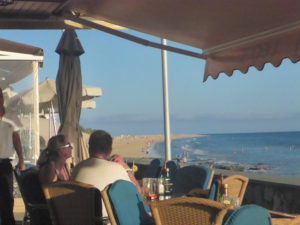
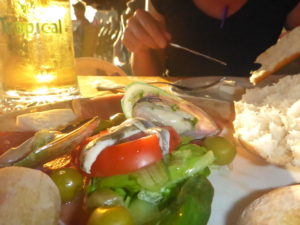
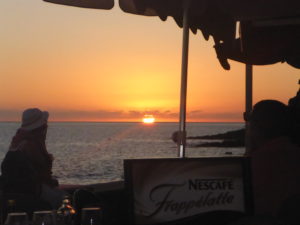
I wrote our first post card to son in law Gary as his birthday card. The lady in the shop said the bus station was behind the football stadium, so we wandered up the hill to check out the rugged tour that operated around the south west of the island. That would make our tour of Fuerteventura complete, Corralejo at the top, Betencuria in the middle and over the highest volcanoes and through Gran Valle to Playa de Cofete in the south.
The bus was a sturdy looking, four wheel drive Mercedes so we knew we were in for something a bit different. Looking forward to the adventure we met our neighbour on the pontoon on the way back. A wiry Frenchman who suggested that if we leave before Monday we would not have to pay. This is not a marina, just a random arrangement of pontoons for visitors and locals. Our neighbour had been ashore before exercising his big brown coated dog who now greeted us with smiling yellow eyes and wagging tail.
After supper we sat in the cockpit and watched four resident geese swim with great fuss and a lot of noise around the harbour; the thought police. Three herons swooped and landed within sight of each-other making raucous barking noises. I have never before heard a heron make any sound at all.
Walking up to the bus station the next morning we passed a budgy, egret, and some native birds whose name eludes me but they were the colour of jays with a black crest on their heads and looked like the American Roadrunner. This little place teemed with colourful birds.
We soon drove beyond the metalled road onto a well ground track with numerous smaller tracks and paths leading off for rugged terrain exploits by quad bike, trucks and on foot. The eroded slopes of the Gran Valle led up to the volcanoes that started erupting 17 million years ago and finished 12 to 14 million years ago. Goats and herders and hunters with their hounds could be seen in the distance and a few shoe-box homes were still in use.
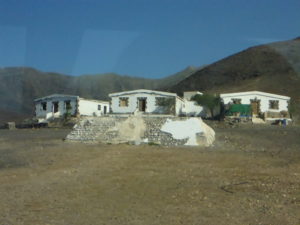
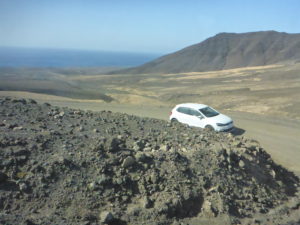
When our bus turned the last high bend to bring us to Cofete beach the wow factor hit us. Playa Barlovento stretched away to the north in glorious golden colours with the turquoise sea delivering long white rollers to its shore and the volcano peaks making descending clouds from the other side. Not a sail in sight.
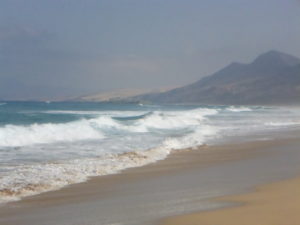
The little hamlet of Cofete had a bar/restaurant but we had brought lunch so we wandered down to the beach to the sound of two donkeys having a loud chat. For nearly two hours we sat in the shade of our rain brolly watching the mighty rollers building and dying just in front of us. No one dared swim but there were a few brave surfers. On our return the bus kept slipping out of gear, often on the rise towards a bend. We remembered our bus trip from Dartmouth and wondered if we might have to get out and push.
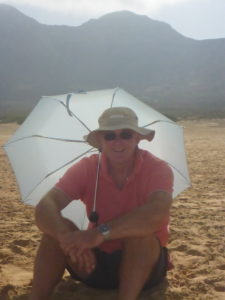
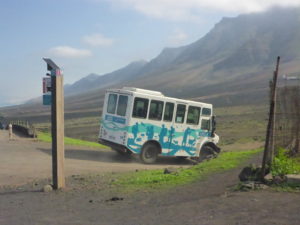
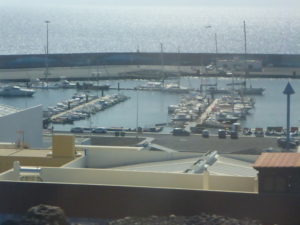
Gran Canaria bound.
Sailors in the Canaries often travel westwards to the next island at night. It is obviously cooler and the winds can be steadier, the acceleration zones losing their strength when the heat of the sun is gone. So we set off at 8.30 that night. We optimistically set the main and genoa but soon they were slatting and banging uselessly in the fickle air.
So we furled them away and started Rupert the engine. Zoonie rolled a fair bit as we were traversing a lava reef 43 metres beneath us for the first 15 miles, but once past it she settled down and by 5.30 the next morning the fingernail moon hung above the space station in the east and mist covered slopes of Gran Canaria could just be made out. The night had been warm and pleasant enough but oh dear, our carbon footprint!
